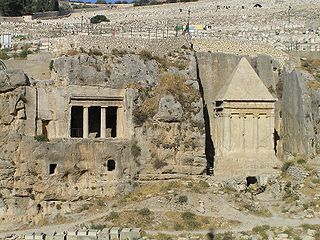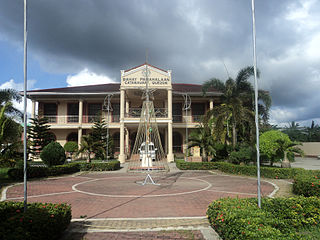
Rock-cut tombs were a form of burial and interment chamber used in ancient Israel. Cut into the landscapes surrounding ancient Judean cities, their design ranges from single chambered, with simple square or rectangular layouts, to multi-chambered with more complex designs. Almost all burial chambers contain a platform for primary burial and an ossuary or other receptacle for secondary burial. There is debate on if these tombs were originally intended for secondary burials, or if that practice arose later.

The Plain of Jars is a megalithic archaeological landscape in Laos. It consists of thousands of stone jars scattered around the upland valleys and the lower foothills of the central plain of the Xiangkhoang Plateau. The jars are arranged in clusters ranging in number from one to several hundred.
In archaeology and anthropology, the term excarnation refers to the practice of removing the flesh and organs of the dead before burial. Excarnation may be achieved through natural means, such as leaving a dead body exposed to the elements or for animals to scavenge; or by butchering the corpse by hand. Following excarnation, some societies retrieved the bones for burial. Excarnation has been practiced throughout the world for hundreds of thousands of years. The earliest archaeological evidence of excarnation is from the Awash River Valley in Ethiopia, 160,000 years ago. Examples of excarnation include 'sky burials' in parts of Asia, the Zoroastrian 'Tower of Silence', and Native American 'tree burials'. Excarnation is practiced for a variety of spiritual and practical reasons, including the Tibetian spiritual belief that excarnation is the most generous form of burial and the Comanche practical concern that in the winter the ground is too hard for an underground burial. Excarnation sites are identifiable in the archaeological record by a concentration of smaller bones, which would be the bones that would be the easiest to fall off the body, and that would not be noticed by practitioners of excarnation.

The Maitum anthropomorphic burial jars are earthenware secondary burial vessels discovered in 1991 by the National Museum of the Philippines' archaeological team in Ayub Cave, Barangay Pinol, Maitum, Sarangani Province, Mindanao, Philippines. The jars are anthropomorphic; characterized by a design that suggests human figures with complete or partial facial features of the first inhabitants of Mindanao. Furthermore, they give emphasis to the Filipinos’ popular belief of life after death.

The Cardamom Mountains, or the Krâvanh Mountains, is a mountain range in the south west of Cambodia and Eastern Thailand. The majority of the range is within Cambodia.

Catanauan, officially the Municipality of Catanauan, is a 1st class municipality in the province of Quezon, Philippines. According to the 2020 census, it has a population of 72,752 people.

The Bura culture refers to a set of archeological sites in the lower Niger River valley of Niger and Burkina Faso. More specifically, the Iron Age civilization exemplified by the Bura culture was centered in the southwest portion of modern-day Niger and in the southeast part of contemporary Burkina Faso.

The secondary burial, or “double funeral” is a feature of prehistoric and historic gravesites. The term refers to remains that represent an exhumation and reburial, whether intentional or accidental.
Dewil Valley, located in the northernmost part of Palawan, an island province of the Philippines that is located in the Mimaropa region, is an archaeological site composed of thousands of artifacts and features. According to the University of the Philippines Archaeological Studies Program, or UP-ASP, the closest settlement can be found in New Ibajay, which is covered by the town capital of El Nido, which is located around 9 km (5.6 mi) south-east of Dewil Valley. Physically it measures around 7 km (4.3 mi) long, and 4 km (2.5 mi) wide. It is in this place which the Ille Cave, one of the main archaeological sites, can be found. It is actually a network of 3 cave mouths located at its base. It has been discovered that this site in particular has been used and occupied by humans over multiple time periods.
The Philippines is an archipelago located in Southeast Asia and consists of 7,641 islands. Prehistoric beads are among the most significant resources deriving from the human past. They are artifacts that inform individuals about archaeological records. Beads play a vital role in Asian lives, since they were utilized as human markers to indicate a territory; moreover, prehistoric beads were significant for ancestors as well as the people who occupied the identical territory. For instance, if beads are perished or destroyed, they can be recovered archaeologically due to their durability, which allows for the preservation of these resources. Furthermore, several of the decorative pieces and tools that they possess, as well as their culture, seem to reflect this maritime characteristic. Due to the fact that beads are transportable, compact in size, and appealing to the eye, they can essentially be discovered all over the world. Tools such as choppers made of shells as well as decorative pieces like shell beads are common in Southeast Asian archaeological records due to this characteristic. Various sites have been found to contain shell beads, including Sucgang Barrio in Bohol; Sibale Island, near Surigao; Suluan island, south of Samar; Lagen Island in Palawan; and Camotes Islands.

Klin-Yar is a prehistoric and early medieval site in the North Caucasus, outside of Kislovodsk. It was first discovered in the 1980s. Archaeological excavations had uncovered settlement traces and extensive cemetery areas starting in the 8th century BC, belonging to the Koban culture. The site was used up to the 7th century AD. Its long use over all this period, its size and rich finds, as well as the data quality of recent excavations make Klin-Yar one of the most important archaeological sites of the region.

Archaeology of Qatar as a field study began in 1956. Three major expeditions were carried out in Qatar throughout the mid-20th century, with the first being launched by a Danish team who began work in the 1950s. This was followed by British and French expeditions in 1970s and 1980s, respectively. Approximately 200 archaeological sites were discovered during these expeditions, with the most extensive being the coastal areas of Al Da'asa, Ras Abrouq and Al Khor Island. Artifacts such as flint tools, Ubaid and Barbar pottery and encampments were found in situ.
Njoro River Cave is an archaeological site on the Mau Escarpment, Kenya, that was first excavated in 1938 by Mary Leakey and her husband Louis Leakey. Excavations revealed a mass cremation site created by Elmenteitan pastoralists during the Pastoral Neolithic roughly 3350-3050 BP. Excavations also uncovered pottery, beads, stone bowls, basket work, pestles and flakes. The Leakeys' excavation was one of the earliest to uncover ancient beads and tools in the area and a later investigation in 1950 was the first to use radiocarbon dating in East Africa.

The Iron Gates Mesolithic is a Mesolithic archaeological culture, dating to between 13,000 and 6,000 years cal BCE, in the Iron Gates region of the Danube River, in modern Romania and Serbia.
Gebel Ramlah is a region in the Western Desert of southern Egypt that was occupied throughout the African Pastoral Neolithic. Archaeological research has focused primarily on individual burial sites and six pastoral cemeteries, including the earliest known infant cemetery in the world. The Gebel Ramlah cemeteries were active during the Final Neolithic in the fifth millennium BC. Ongoing excavation has uncovered over 200 human burials and elaborate grave goods. Research studies have been done on the pottery, mollusk shells, archaeobotanical remains, and skeletal remains found throughout the sites.
Maeung Fa Daet Song Yang is a significant moated archaeological site in Northeast Thailand along the Pao River. The site is located in the Kamalasai district, Kalasin province on the Khorat Plateau with the Sakhon Nakhon basin to the north, and the Chi River system to the south. The site on Muang Fa Daed was also an excellent location for trade and transportation due to its proximity to multiple waterways. This site shows evidence of a large-scale Buddhist community and is often associated with the Davaravati culture based on the multitude of artifacts and features found at the site. The site was first excavated in 1968 and later by Phasook Indrawood in 1991, who dug nine test pits and found two phases of occupation. This region also indicated that agriculture was a large part of the lifestyle here. The site was thought to have been founded by Chao Fa Ra-ngum in 621 AD.
Old Kiyyangan Village (OKV) is an archeological site in the Lazo highlands in the province of Ifugao in the Cordillera Administrative Region of the Philippines. The importance of this site is the presence of the Ifugao people and culture as the first inhabitants in the valley, who also represent one of the major indigenous Filipino societies for rice cultivation. This site is surrounded by rice terraces used for agricultural practices and remain heavily debated as to when and how recent these terraces formed. Artifacts found at this site suggest a strong influence of Christianity, mortuary rituals, and a system that defined social status according to the accumulation of various beads and ceramics.
Prohear is an archaeological site from the Early Iron Age located in the Prey Veng province of Cambodia between the capital city of Phnom Penh and the border with Vietnam. By the time the site became known to archaeologists in 2007, it had been heavily looted and few archaeological materials remained. Prohear is known for its burials and uniquely rich array of grave goods including numerous precious metal artifacts. A number of the artifacts excavated at the site have contributed to the study of trade routes that connected Prohear to the rest of Southeast Asia.
The Cardamom Mountains jar burials are a collection of twelve mortuary sites dating back to the late and post-Angkor period located in the Eastern region of Cambodia's Cardamom Mountains. In recent years, these sites have gained interest due to their unique wooden coffins and vast collections of large, ceramic jars that often hold multiple human skeletons. These remains encompass both adolescents and adults who are speculated to be from the highland populations that inhabited Cambodia's mountain range. Various types of grave goods have also been discovered inside and around these burial jars including glass beads, ceramics, and metal jewelry from maritime trade across South and Southeast Asia.

















